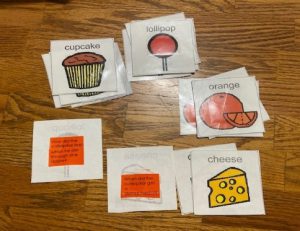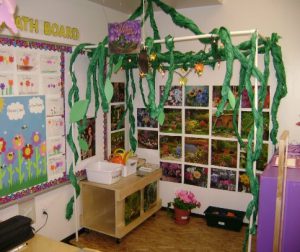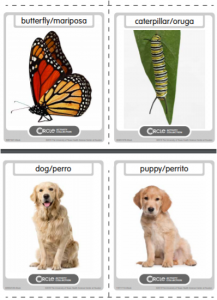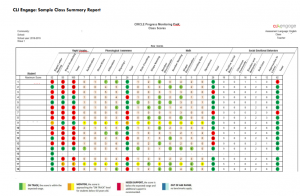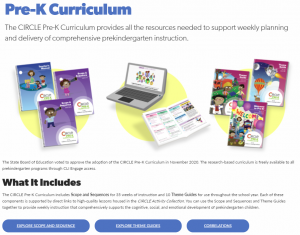A PUBLICATION OF THE CHILDREN'S LEARNING INSTITUTE |
||
 |
||
|
Integrating Cognitive Concepts throughout the Day April 2021 Relevant ResearchTeachers have their hands full with trying to accomplish so much instruction in a day, while also providing support to children and maintaining an organized classroom. How can teachers maximize their effectiveness and still teach the needed skills? Teachers can maximize their effectiveness by planning:
Use read aloud books for relating content across various domains Teachers can use books that they are reading to help children connect and link to the learning across multiple domains. As an example, “Ten Black Dots” by Donald Crews is a mathematical focused book that with children can count along with as the teacher reads the book. Throughout the day, the teacher can also ask questions, introduce vocabulary, and provide an extension activity that addresses multiple domain areas and different activities that make sense because they are in context with the shared book reading. In addition, teachers can expand the focus beyond counting by incorporating language and communication, emergent reading, or emergent writing activities for practicing skills either before, during, or after the book reading. Use songs and finger plays throughout the day One way to add cognitive concepts throughout the day is to use songs and finger plays. In a typical classroom, there can be up to two hours of wait time as children wait to transition to other areas, wait to go to the bathroom, wait for lunch, and so on. Songs and finger plays are very helpful to take advantage of the wait time and add instructional value to get the children to think about or practice skills. A teacher can incorporate different vocabulary words by rotating new songs and finger plays that incorporate words from their weekly theme, book vocabulary, and other introduce new words to the children. Support learning through play Children often learn through play, thus making it easy for teachers to integrate new instructional practices into activities that already occur in the classroom environment, like centers and small groups. By integrating cognitive concepts into different centers and small groups, teachers can optimize a child’s learning. For example, for a small group activity, a teacher may fill plastic eggs with items of varying weights, such as paper clips, gravel, and cotton balls, so that the children can feel them and differentiate between lighter and heavier eggs. The teacher can then introduce how to use a scale. Afterwards, the teacher can place the eggs and scale into the math center for children to use the scale independently during learning center time.
Be intentional when asking questions According to the National Association for the Education of Young Children (Strasser & Bresson, 2015), “asking higher-level questions allows children to expand their thinking and perspective on a subject. At each level, the questions become more difficult and require deeper thinking before a child can respond.” Higher-level thinking questions are a great way to expand upon a child’s thinking and language. For teachers, creating higher-order thinking questions on the spot can be challenging. Teachers can prepare higher-level thinking questions by:
Use themes Another way to engage children with cognitive concepts is to use themes within the classroom environment. The classroom environment can be modified and adjusted to bring in cognitive concepts that are theme related, allowing children to use new vocabulary in meaningful ways and link it to learning. Teachers can transform their classroom into the theme. For a garden theme, the centers can transform into different theme-related areas or add theme-related activities into existing centers. Some examples include:
Use the CIRCLE Online Activity Collection Teachers can engage children and use the CIRCLE Activity Collection: Pre-K to Grade 2 Classroom (CAC) to provide extension activities after a book read, to supplement various thematic activity ideas, and to practice skills in small groups. For example, in the CAC activity called “Growing and Changing” the activity targets the life science domain area and includes a link underneath the materials section with picture cards that teachers can print out to use or display during virtual learning. Activities are available in English & Spanish for prekindergarten to second grade teachers to use with children. Integrating cognitive concepts maximizes children’s learning In essence, teachers can use limited class time by planning for wait times and taking advantage of adding cognitive activities into their classroom environment. By providing additional skill development opportunities every day in planful, playful and purposeful ways, teachers can integrate cognitive concepts to maximize children’s learning. Reference Strasser, J., Bresson, L. M. (2015). Moving Beyond Who, What, When, Where, and Why: Using Bloom’s Taxonomy Questioning to Extend Preschoolers’ Thinking. Teaching Young Children, 9(1). https://www.naeyc.org/resources/pubs/tyc/oct2015/using-blooms-taxonomy-questioning Teaching TipsUsing the child progress monitoring data from observations and assessment results, teachers can create a list of skills that they may want to focus on with the children. The Class Summary Report is a great tool for teachers to identify specific skills that the entire class needs. This is a great resource to focus on specific skills needed and connect them to the current theme. When more than half of the class shows scores of needs support, the skill is considered to be emergent for those students. This skill is a great one to incorporate into different contexts throughout the day.
Another resource available is the CIRCLE Pre-K Curriculum, which addresses all ten domains of the Texas Prekindergarten Guidelines with comprehensive support of cognitive, social, and emotional development, and includes 35 weeks of lesson plans. The CIRCLE Pre-K Curriculum is available at no cost on the CLI Engage platform and anyone with a CLI Engage account can freely access the pre-K curriculum online.
Recommended Resources
|
||
|
||||


